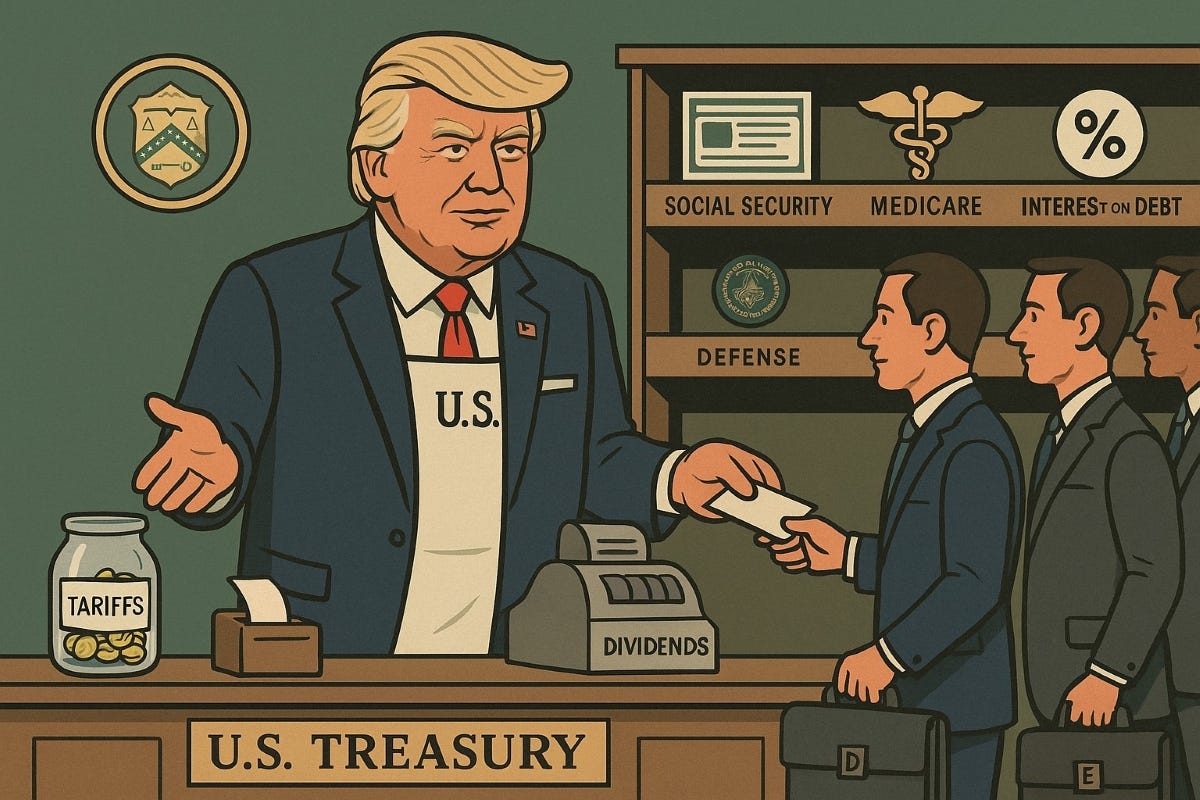How Trump May Have Solved America's Fiscal Dilemma
How you can shrink the deficit without raising taxes or slashing entitlement spending.
Note: Added a section to the end talking about the other side of the fiscal equation, reducing spending.
How Trump May Have Solved the “Raise Revenue Without Raising Taxes” Problem
In our Intel post, we argued that Washington taking a minority stake in a strategically important firm isn’t socialism; it’s an instrument of industrial policy used in highly capitalist countries such as Singapore.
Since then, officials have floated doing more of these minority stakes—including in defense contractors—and reporting indicates Exxon has quietly discussed re-entering a joint venture with Rosneft if relations normalize. Put together, this sketches a politically viable way to raise federal revenue (and potentially shrink deficits) without hiking statutory income-tax rates.
Intel: The White House and Intel announced a ~$8.9B equity investment for roughly 10% of the company; Intel’s own disclosure flags cross-border/compliance risks even as the White House hints at more deals (Fox Business).
Defense stakes next? Commerce Secretary Howard Lutnick said the administration is considering equity stakes in primes such as Lockheed Martin (Washington Post).
Context: Lockheed’s customer mix is dominated by governments—~73% U.S. government per its 10-K, and ~92% government overall including foreign sovereigns (Lockheed 10-K, TenderAlpha summary).
Exxon–Rosneft backchannel: Multiple outlets report talks about resuming Sakhalin-1 if governments green-light it as part of broader détente (WSJ, Bloomberg summary, Reuters).
None of this is “state control.” They’re negotiated, minority positions in exchange for explicit policy support—more sovereign-investor than command economy.
The political constraint this sidesteps
Modern democracies rarely cut benefits or raise broad-based income taxes. Meanwhile, the federal income-tax take has grown more progressive over time—the top 1% now pay roughly ~40–46% of income taxes, depending on the year (Tax Foundation 2025 update; see also IRS SOI). That makes “raise the rates” a hard sell.
Tariffs solved part of this political problem by acting like a diffuse consumption tax. Whatever you think of the economics, the budget math isn’t trivial: the CBO now scores recent tariff changes as reducing deficits by roughly $4T over ten years (White House citing CBO here; CBO dataset entry here). (Skeptics dispute the framing, but the score itself traces back to CBO.)
Layer on dividends/buybacks from minority stakes in cash-generative firms, and Treasury gets a second revenue stream without an income-tax vote.
A (counterintuitive) macro upside of regressive taxes
Economically, tariffs and other consumption-style taxes are regressive—they bite a larger share of income for lower-income households (Yale Budget Lab, CRS, Cato overview). But there’s a stabilization wrinkle: lower-income households have higher marginal propensities to consume (MPC), so regressive taxes reduce aggregate demand more per dollar raised—which can check inflation when the economy is overheated (Boston Fed MPC paper; see also evidence reviews ECB and a macro treatment in JME-adjacent work, e.g., Bilbiie 2024 abstracted here).
Applied to 2021–22, several Fed/academic reads find COVID-era fiscal transfers contributed meaningfully to U.S. inflation—on the order of ~2.5–3.0 percentage points at peak—alongside supply shocks (Fed Board FEDS Note, Fortune summary of Fed work, NY Fed staff paper, FRBSF supply-vs-demand tracker). In that context, tariffs/consumption-type levies can help drain residual excess demand created by transfers—especially because they fall on high-MPC households—while still raising revenue.
Why equity stakes add up (and why defense may be first)
Defense primes are already public-risk passthroughs with private shareholders. If the public is the buyer of record and guarantor of demand, a modest equity slice simply returns some upside to taxpayers. Lockheed’s filings make the dependence explicit (again: ~73% U.S. government revenue) and analyst tallies peg ~92% including foreign governments (SEC 10-K, TenderAlpha). Intel’s own risk section underscores the geopolitical/market frictions a U.S. stake can create—but the policy template is now live (Fox Business).
The Exxon example (dilution isn’t destiny)
Suppose détente enables an Exxon Mobile (XOM 0.00%↑)–Rosneft restart and the administration asks for 5% of Exxon as the “policy stability” fee. Yes, that’s ~5% dilution. But if the joint venture’s incremental free cash flow boosts dividends/buybacks, per-share math for existing holders can turn net-positive within a few quarters, while taxpayers collect dividends on the public stake—no income-tax vote required (Bloomberg, Reuters). Treat this as illustrative until any deal is public.
Patents: a third (early) lever
The administration has invoked Bayh-Dole compliance and threatened “march-in” on Harvard-linked patents—unusually aggressive but not the same as a formal revenue-sharing regime. There’s talk of value-based fee tweaks and tighter enforcement, but nothing finalized yet.
The revenue stack, at a glance
Tariffs (diffuse consumption-style): now CBO-scored to reduce 10-year deficits by ~$4T under current policy (White House citing CBO; CBO post here).
Minority stakes: recurring dividend/buyback participation plus potential exit gains (Intel now; defense under evaluation).
IP enforcement/fees (early): Bayh-Dole march-in posture + prospective fee changes (not yet promulgated).
Bottom line: If the objective is to shrink deficits without touching marginal income-tax rates or entitlements, tariffs + minority equity stakes is a coherent (and politically feasible) playbook. Add a legally sound IP monetization tweak, and you have durable, voter-palatable cash flows that don’t look like “tax hikes”—even if, functionally, they help fund the state.
This still leaves the spending side
Of course, increasing government revenues is only one half of the fiscal equation. The other half is reducing spending. The Trump administration has two levers here, one it has already started pulling on: mass deportations of illegal aliens. Illegal aliens consume more in government resources than they pay in taxes, so, all else equal, removing them should lower government spending over time. And deportation flights have hit record numbers this summer. We recently opened a trade designed to profit from these deportations:
Trade Alert: Deportations And Secondary Sanctions
Macro Backdrop: Deportations And Secondary Sanctions
The other lever the Trump administration hasn’t started pulling on yet (and will likely have to wait until the resolution of the Russia-Ukraine war) is negotiating reciprocal defense spending cuts with Russia and China. Trump suggested cuts of 50% earlier this year. Taken together, both levers could reduce entitlement spending as well as defense spending.






One thing I like about this strategy is that it serves as a shot across the bow of any "too big to fail" businesses/industries.
Much if not all of our problems as a country come from the ability to spend without constraints. Hopefully this fails and sane spending becomes mandatory.